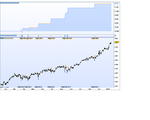Wicked_Daddy
Active member
- Messages
- 128
- Likes
- 48
Greetings all,
Been awhile since I checked in. Some friends and I had a lively discussion about the future of US stocks over the next 2 years, with the S&P being the gauge. I would like to get a more "world view" from traders here.
So, what is your prediction for the S&P over the next couple years? Do you base your opinion on TA, FA or both?
I'll start by saying that the current bull cycle has become almost parabolic and over-stretched (technically). Clearly, a correction is due but the market has lacked a strong enough fundamental catalyst to sustain any depth. Still, the further it pushes upward, the weaker the catalyst can be to cause a frenzy of profit taking and then a fear based sell-off. I think we could see a mild correction mid summer, 2018, which would mark the first "lower low" with a recovery not to exceed the current average. Then a real correction to 50% of the almost parabolic rise from 2000, to around 2300 or as far as returning to the previous 2000 area, which held steady for approximately 18 months from late 2014 through mid 2016.
Been awhile since I checked in. Some friends and I had a lively discussion about the future of US stocks over the next 2 years, with the S&P being the gauge. I would like to get a more "world view" from traders here.
So, what is your prediction for the S&P over the next couple years? Do you base your opinion on TA, FA or both?
I'll start by saying that the current bull cycle has become almost parabolic and over-stretched (technically). Clearly, a correction is due but the market has lacked a strong enough fundamental catalyst to sustain any depth. Still, the further it pushes upward, the weaker the catalyst can be to cause a frenzy of profit taking and then a fear based sell-off. I think we could see a mild correction mid summer, 2018, which would mark the first "lower low" with a recovery not to exceed the current average. Then a real correction to 50% of the almost parabolic rise from 2000, to around 2300 or as far as returning to the previous 2000 area, which held steady for approximately 18 months from late 2014 through mid 2016.

